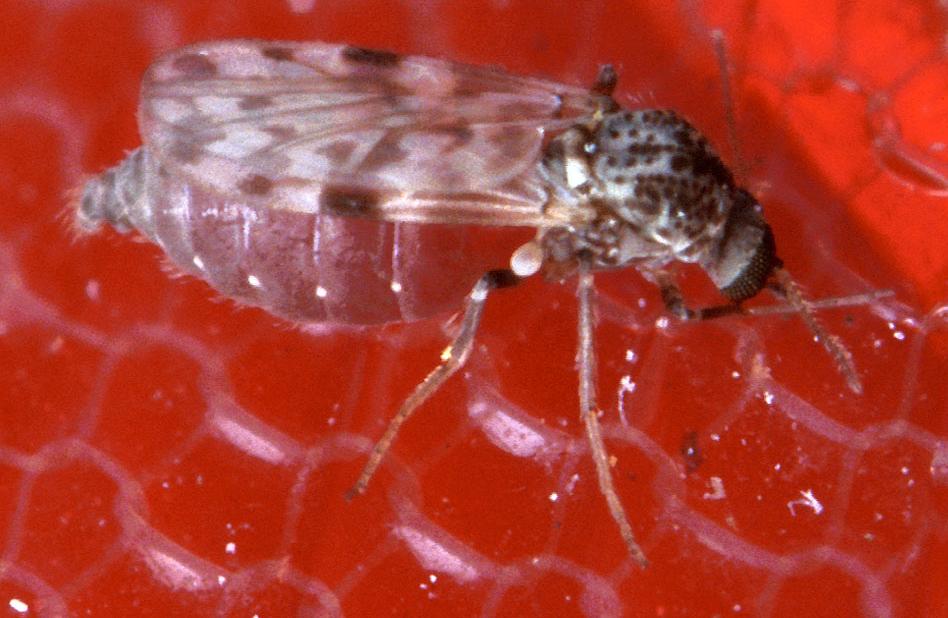 A No Seeum feasting on a finger, to scale. Photo: Creative Commons If you own a tent, you’ve probably noticed that the holes in the bug mesh screening are quite fine—typically over 1,000 holes per square inch, much finer than your average window screen in a house. The holes have to be this fine in order to keep out “No Seeums" (Ceratopogonidae), the tiniest of biting flies, so tiny that you have to squint in order to see them. In fact, if it’s dark out, you won’t see them at all, unless you happen to shine your headlamp closely on one as it feasts on you. No Seeums, also known as “punkies” and “moose flies” are a family of biting midges 1-3 millimeters in length and translucent grey in color. They have a striped wing pattern that is barely visible to the naked eye in larger specimens. Their tiny size (about half to one quarter the size of a Black Fly) and translucent color makes them nearly invisible. If you find yourself suddenly feeling itchy in the dawn or dusk, or after dark, but can’t identify the cause, you may be the victim of a No Seeum attack. Despite their tiny size, their bite packs a punch, and like Black Flies, they slice holes in the skin then lick out the blood. Season & Habitat Here in the northeast, No Seeums are most active in the twilight hours, on moderate to warm nights in the spring and early summer, near wetlands and still bodies of water. They prefer damp conditions; drought will substantially reduce their numbers. Unlike other biting flies, their larvae are not aquatic. No Seeums are not known to be vectors of pathogens in the northeast, but some people are allergic to their bites (the allergy can cause painful, long lasting itchiness). Ecology and Behavior Like other species of biting fly, adult No Seeums feed on plant nectars; females will procure blood for nutrients used in egg production. Like mosquitos and black flies, No Seeums tend to attack in mobs. Overall, No Seeums are more localized and less omnipresent than mosquitos and black flies and they tend to travel less far in search of blood; sometimes it is possible to escape them by moving away from their home turf a relatively short distance, and it’s quite easy to out-walk them. I’ve never had a problem with them while hiking—only when I stop and settle down for the evening. They are too tiny to bite through clothing but can easily slip under cuffs and down collars. They will bite any area of exposed skin. They will sometimes pass through house window screens to bite people inside. Thwarting No-Seeums Cold weather or a strong breeze will drive No Seeums away, as will campfire smoke, natural insect repellants (such as lemon-Eucalyptus concoctions) and man-made chemical repellents (DEET, Picaridin) insect repellants. While most tents come equipped with mesh netting fine enough to keep out No-Seeums, you can easily carry them into your tent on your clothing or skin—shine a headlamp near the apex of your tent after you get inside, and squash any that came in with you (or else they will find you later). If you’re sleeping in a lean-to in No-Seeum habitat, they will come inside the lean-to to bite—in which case you could protect yourself with an insect repellent or with an over the sleeping bag mesh bug net—but make sure you buy netting with very fine holes (some cheap bug nets on the market aren’t fine enough to keep out No Seeums). There are few fates more torturous than being bit all night by nearly invisible bugs. If you do end up reacting to No-Seeum bites, consider anti-inflammatory creams containing Benadryl or other salves to reduce itchiness.
0 Comments
Leave a Reply. |
TOPICS
All
Humor (The Parsnip)

|
Proudly powered by Weebly

 RSS Feed
RSS Feed
